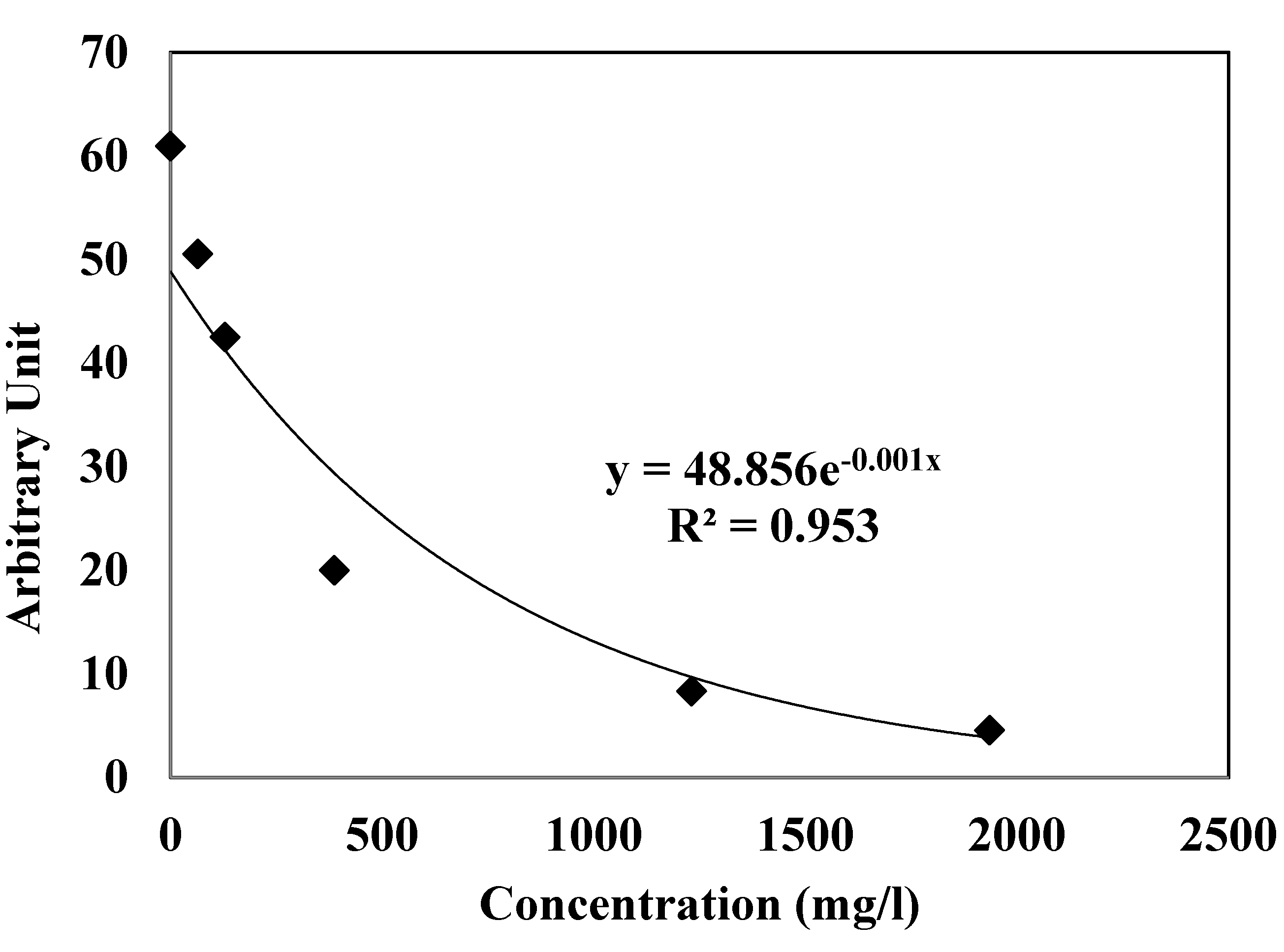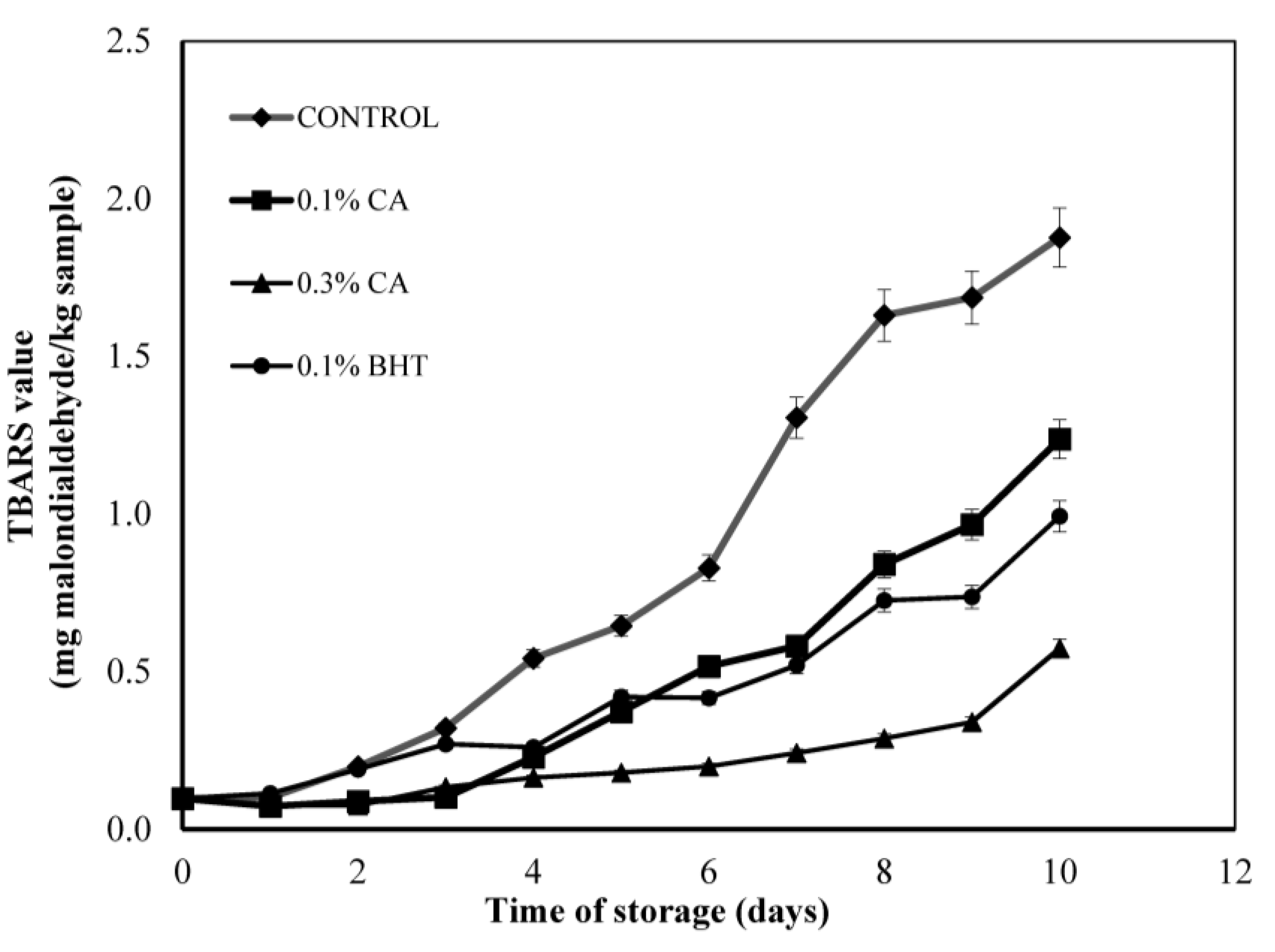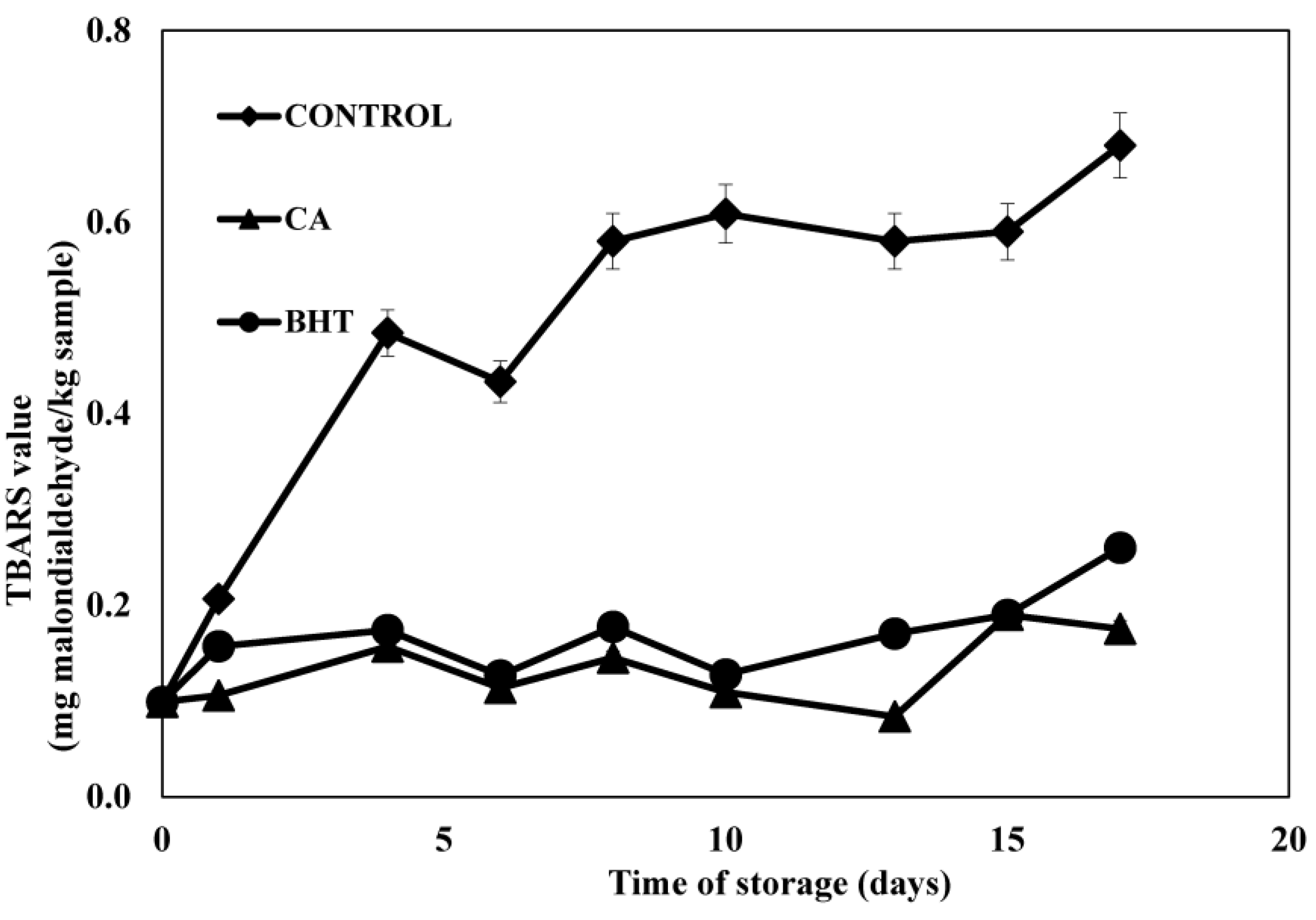The Effect of Convolvulus arvensis Dried Extract as a Potential Antioxidant in Food Models
Abstract
:1. Introduction
2. Experimental Section
2.1. Plant Material
2.2. Extraction of CA Extract
2.3. Determination of the Total Phenolic Content (TPC)
2.4. Determination of Free Radical Scavenging Activity Assays
2.4.1. In-Vitro Antioxidant Capacity Determination
2.4.2. Electron Paramagnetic Resonance (EPR) Spectroscopy Radical Scavenging Assay
2.5. Determination of Antioxidant Activity in Food Model
2.5.1. Preparation of Beef Patties
2.5.2. TBARS Assay
2.5.3. Colour Measurement
2.5.4. Percentage of Metmyoglobin
2.5.5. Development of Gelatin-Film with Antioxidant Coating
2.6. Statistical Analysis
3. Results and Discussion
3.1. Analysis of Total Polyphenols and Free Radical Activity Assays
| Activity Convolvulus arvensis | Extraction Solvent | ||
|---|---|---|---|
| 50:50 EtOH:H2O | 75:25 EtOH:H2O | 90:10 EtOH:H2O | |
| Soluble concentration (g/L) | 13.76 ± 0.05 | 13.61 ± 0.02 | 11.43 ± 0.05 |
| Total phenolic content (g GAE/g DW) | 13.0 ± 0.05 | 12.1 ± 0.03 | 9.9 ± 0.02 |
| FRAP (mmol of TE/g DW) | 1.62 ± 0.02 | 1.51 ± 0.06 | 0.98 ± 0.01 |
| TEAC (mmol of TE/g DW) | 1.71 ± 0.01 | 1.68 ± 0.01 | 1.41 ± 0.04 |
| ORAC (mmol of TE/g DW) | 2.11 ± 0.05 | 2.05 ± 0.05 | 1.71 ± 0.03 |
3.2. EPR Scavenging Radical Assay

3.3. Antioxidant Activity in Model Food
3.3.1. Colour and % Metmyoglobin
| Assay | Sample | Days of Storages | |||||
|---|---|---|---|---|---|---|---|
| 0 | 2 | 4 | 6 | 8 | 10 | ||
| L* | Control | 38.68 ± 0.87 a,1 | 38.68 ± 1.50 a,1 | 37.89 ± 0.32 b,3 | 37.10 ± 1.23 b,2 | 36.23 ± 0.45 c,2 | 35.61 ± 2.22 d,1 |
| 0.1% BHT | 38.68 ± 0.87 a,1 | 39.06 ± 1.08 b,2 | 38.25 ± 0.97 a,2 | 38.43 ± 1.06 a,1 | 37.09 ± 1.19 c,1 | 36.18 ± 0.46 c,2 | |
| 0.1% CA | 38.68 ± 0.87 a,1 | 38.60 ± 1.05 a,1 | 39.26 ± 1.46 b,1 | 38.63 ± 0.55 a,1 | 37.11 ± 1.02 c,1 | 37.06 ± 1.22 c,3 | |
| 0.3 % CA | 38.68 ± 0.87 a,1 | 39.94 ± 0.71 b,2 | 39.79 ± 1.23 b,1 | 38.25 ± 1.40 a,1 | 38.91 ± 1.47 a,3 | 38.84 ± 1.13 a,4 | |
| a* | Control | 7.49 ± 0.27 a,1 | 7.77 ± 0.29 a,1 | 6.54 ± 0.33 b,1 | 6.27 ± 0.16 b,2 | 4.71 ± 0.02 c,1 | 2.09 ± 0.01 d,1 |
| 0.1% BHT | 7.49 ± 0.27 a,1 | 8.18 ± 0.42 b,2 | 9.28 ± 0.28 c,2 | 7.05 ± 0.31 a,1 | 6.36 ± 0.37 d,2 | 2.87 ± 0.01 e,1 | |
| 0.1% CA | 7.49 ± 0.27 a,1 | 7.61 ± 0.33 a,1 | 5.57 ± 0.26 b,3 | 6.25 ± 0.19 c,2 | 6.60 ± 0.33 c,2 | 3.31 ± 0.02 d,2 | |
| 0.3 % CA | 7.49 ± 0.27 a,1 | 7.64 ± 0.21 a,1 | 7.20 ± 0.47 a,4 | 7.50 ± 0.20 a,1 | 7.61 ± 0.37 a,3 | 4.08 ± 0.01 b,3 | |
| b* | Control | 7.42 ± 0.32 a,1 | 4.86 ± 0.01 b,1 | 7.68 ± 0.36 a,1 | 8.55 ± 0.19 c,1 | 9.95 ± 0.21 d,1 | 6.77 ± 0.02 e,1 |
| 0.1% BHT | 7.42 ± 0.32 a,1 | 6.68 ± 0.16 b,2 | 8.40 ± 0.27 c,1 | 8.39 ± 0.37 c,1 | 8.38 ± 0.24 c,2 | 6.10 ± 0.01 d,1 | |
| 0.1% CA | 7.42 ± 0.32 a,1 | 8.00 ± 0.37 b,3 | 8.19 ± 0.33 b,1 | 5.17 ± 0.13 c,2 | 7.49 ± 0.07 a,3 | 4.35 ± 0.09 d,2 | |
| 0.3 % CA | 7.42 ± 0.32 a,1 | 7.14 ± 0.49 a,4 | 7.59 ± 0.29 a,2 | 7.01 ± 0.21 a,3 | 7.99 ± 0.27 a,3 | 3.25 ± 0.01 b,3 | |
3.3.2. TBARS Analysis in Beef Patties
3.3.3. TBARS Analysis in Meat under Active Packaging
| Assay | Sample | Day of Storages | |||||
|---|---|---|---|---|---|---|---|
| 0 | 2 | 4 | 6 | 8 | 10 | ||
| % Metmyoglobin | Control | 23.38 ± 0.46 1 | 29.19 ± 0.71 2 | 37.56 ± 1.31 2 | 47.84 ± 1.21 1 | 53.9 ± 1.16 1 | 60.03 ± 2.82 2 |
| 0.1% BHT | 23.38 ± 0.46 1 | 25.69 ± 1.04 4 | 29.98 ± 0.81 1 | 37.5 ± 1.85 2 | 45.7 ± 1.53 2 | 57.6 ± 1.24 1 | |
| 0.1% CA | 23.38 ± 0.46 1 | 27.96 ± 0.33 1 | 33.48 ± 0.79 3 | 44.81 ± 1.29 3 | 48.7 ± 1.67 3 | 57.1 ± 1.18 1 | |
| 0.3 % CA | 23.38 ± 0.46 1 | 28.91 ± 0.81 1,2 | 30.71 ± 0.29 1 | 33.37 ± 0.94 4 | 40.1 ± 1.53 4 | 50.78 ± 1.56 3 | |


4. Conclusions
Acknowledgments
Author Contributions
Conflicts of Interest
References
- Alvarez-Suarez, J.M.; Giampieri, F.; González-Paramás, A.M.; Damiani, E.; Astolfi, P.; Martinez-Sanchez, G.; Bompadre, S.; Quiles, J.L.; Santos-Buelga, C.; Battino, M. Phenolics from monofloral honeys protect human erythrocyte membranes against oxidative damage. Food Chem. Toxicol. 2012, 50, 1508–1516. [Google Scholar] [CrossRef] [PubMed]
- Zhao, G.; Yin, Z.; Dong, J. Antiviral efficacy against hepatitis B virus replication of oleuropein isolated from Jasminum officinale L. var. grandiflorum. J. Ethnopharmacol. 2009, 125, 265–268. [Google Scholar] [CrossRef] [PubMed]
- Chang-Liao, W.-L.; Chien, C.-F.; Lin, L.-C.; Tsai, T.-H. Isolation of gentiopicroside from Gentianae Radix and its pharmacokinetics on liver ischemia/reperfusion rats. J. Ethnopharmacol. 2012, 141, 668–673. [Google Scholar] [CrossRef] [PubMed]
- Halliwell, B. Antioxidants in human health and disease. Annu. Rev. Nutr. 1996, 16, 33–50. [Google Scholar] [CrossRef] [PubMed]
- Martín-Sánchez, A.M.; Navarro, C.; Pérez-Álvarez, J.A.; Kuri, V. Alternatives for Efficient and Sustainable Production of Surimi: A Review. Compr. Rev. Food Sci. Food Saf. 2009, 8, 359–374. [Google Scholar] [CrossRef]
- Suppakul, P.; Miltz, J.; Sonneveld, K.; Bigger, S.W. Active Packaging Technologies with an Emphasis on Antimicrobial Packaging and Its Applications. J. Food Sci. 2003, 68, 408–420. [Google Scholar] [CrossRef] [Green Version]
- Siripatrawan, U.; Noipha, S. Active film from chitosan incorporating green tea extract for shelf life extension of pork sausages. Food Hydrocoll. 2012, 27, 102–108. [Google Scholar] [CrossRef]
- Chopra, R.N.; Nayar, S.L.; Chopra, I.C. Glossary of Indian Medicinal Plants (Including Supplement); CSIR: New Delhi, India, 1986. [Google Scholar]
- Foster, S.; Duke, J.A. A Field Guide of Medicinal Plants; Houghton Mifflin Co.: New York, NY, USA, 1990. [Google Scholar]
- Meng, X.L.; Riordan, N.H.; Casciari, J.J.; Zhu, Y.; Gonzalez, J.M.; Miranda-Massari, J.R.; Riordan, H.D. Effect of High Molecular Mass Convolvulus arvensis Extract on Tumor Growth and Angiogenesis. Pharmacognosis 2002, 21, 323–328. [Google Scholar]
- Ghasemi, N.; Kohi, M. Cytotoxic effect of Convolvulus arvensis extracts on human cancerous cell line. Iran. J. Pharm. Res. 2008, 3, 31–34. [Google Scholar]
- Al-Bowait, M.E.; Albokhadaim, I.F.; Homeida, A.M. Immunostimulant Effect of Binweed (Convolvulus arvensis) Extract in Rabbit. Res. J. Pharmacol. 2010, 4, 51–54. [Google Scholar] [CrossRef]
- Thakral, J.; Borar, S.; Kalia, A.N. Antioxidant Potential Fractionation from Methanol Extract of Aerial Parts of Convolvulus arvensis Linn (Convolvulaceae). Int. J. Pharm. Sci. Drug Res. 2010, 2, 219–223. [Google Scholar]
- Hegab, M.M.; Ghareib, H.R. Methanol Extract Potential of Field Bindweed (Convolvulus arvensis L) for Wheat Growth Enhancement. Int. J. Bot. 2010, 6, 334–342. [Google Scholar] [CrossRef]
- Zhang, S.; Bi, H.; Liu, C. Extraction of bio-active components from Rhodiola sachalinensis under ultrahigh hydrostatic pressure. Sep. Purif. Technol. 2007, 57, 277–282. [Google Scholar] [CrossRef]
- Santas, J.; Carbo, R.; Gordon, M.; Almajano, M. Comparison of the antioxidant activity of two Spanish onion varieties. Food Chem. 2008, 107, 1210–1216. [Google Scholar] [CrossRef]
- Almajano, M.P.; Carbó, R.; Jiménez, J.A.L.; Gordon, M.H. Antioxidant and antimicrobial activities of tea infusions. Food Chem. 2008, 108, 55–63. [Google Scholar] [CrossRef]
- Skowyra, M.; Falguera, V.; Gallego, G.; Peiró, S.; Almajano, M.P. Antioxidant properties of aqueous and ethanolic extracts of tara (Caesalpinia spinosa) pods in vitro and in model food emulsions. J. Sci. Food Agric. 2014, 94, 911–918. [Google Scholar] [CrossRef] [PubMed]
- Gallego, M.G.; Gordon, M.H.; Segovia, F.J.; Skowyra, M.; Almajano, M.P. Antioxidant Properties of Three Aromatic Herbs (Rosemary, Thyme and Lavender) in Oil-in-Water Emulsions. J. Am. Oil Chem. Soc. 2013, 90, 1559–1568. [Google Scholar] [CrossRef]
- Azman, N.A.M.; Peiró, S.; Fajarí, L.; Julià, L.; Almajano, M.P. Radical scavenging of white tea and its flavonoid constituents by electron paramagnetic resonance (EPR) spectroscopy. J. Agric. Food Chem. 2014, 62, 5743–5748. [Google Scholar] [CrossRef] [PubMed]
- Grau, A.; Guardiola, F.; Boatella, J.; Barroeta, A.; Codony, R. Measurement of 2-thiobarbituric acid values in dark chicken meat through derivative spectrophotometry: Influence of various parameters. J. Agric. Food Chem. 2000, 48, 1155–1159. [Google Scholar] [CrossRef] [PubMed]
- Xu, Z.; Tang, M.; Li, Y.; Liu, F.; Li, X.; Dai, R. Antioxidant properties of Du-zhong (Eucommia ulmoides Oliv.) extracts and their effects on color stability and lipid oxidation of raw pork patties. J. Agric. Food Chem. 2010, 58, 7289–7296. [Google Scholar] [CrossRef] [PubMed]
- Bodini, R.B.; Sobral, P.J.A.; Favaro-Trindade, C.S.; Carvalho, R.A. Properties of gelatin-based films with added ethanol–propolis extract. LWT Food Sci. Technol. 2013, 51, 104–110. [Google Scholar] [CrossRef]
- Fernández-Agulló, A.; Pereira, E.; Freire, M.S.; Valentão, P.; Andrade, P.B.; González-Álvarez, J.; Pereira, J.A. Influence of solvent on the antioxidant and antimicrobial properties of walnut (Juglans regia L.) green husk extracts. Ind. Crops Prod. 2013, 42, 126–132. [Google Scholar] [CrossRef]
- Elzaawely, A.A.; Tawata, S. Antioxidant Activity of Phenolic Rich Fraction Obtained from Convolvulus arvensis L. leaves Grown in Egypt. Asian J. Crop Sci. 2012, 4, 32–40. [Google Scholar] [CrossRef]
- Cachaldora, A.; García, G.; Lorenzo, J.M.; García-Fontán, M.C. Effect of modified atmosphere and vacuum packaging on some quality characteristics and the shelf-life of “morcilla”, a typical cooked blood sausage. Meat Sci. 2013, 93, 220–225. [Google Scholar] [CrossRef] [PubMed]
- Martín-Sánchez, A.M.; Ciro-Gómez, G.; Sayas, E.; Vilella-Esplá, J.; Ben-Abda, J.; Pérez-Álvarez, J.Á. Date palm by-products as a new ingredient for the meat industry: Application to pork liver pâté. Meat Sci. 2013, 93, 880–887. [Google Scholar] [CrossRef] [PubMed]
- Pérez-Álvarez, J.A.; Fernández-López, J. Color Characteristics of Meat and Poultry Analysis, Handbook of Processed Meats and Poultry Analysis. CRC Press: Boca Raton, FL, USA, 2009; pp. 355–373. [Google Scholar]
- Sidhu, J.S. Date Fruits Production and Processing, Handbook of Fruits and Fruit Processing. Blackwell Publishing: Ames, IA, USA, 2006; pp. 391–420. [Google Scholar]
- Sánchez-Escalante, A.; Djenane, D.; Torrescano, G.; Beltrán, J.; Roncalés, P. The effects of ascorbic acid, taurine, carnosine and rosemary powder on colour and lipid stability of beef patties packaged in modified atmosphere. Meat Sci. 2001, 58, 421–429. [Google Scholar] [CrossRef] [PubMed]
- Azman, N.A.M.; Gordon, M.H.; Skowyra, M.; Segovia, F.; Almajano, M.P. Use of lyophilised and powdered Gentiana lutea root in fresh beef patties stored under different atmospheres. J. Sci. Food Agric. 2014. [Google Scholar] [CrossRef]
- Martínez, L.; Djenane, D.; Cilla, I.; Beltrán, J.A.; Roncalés, P. Effect of varying oxygen concentrations on the shelf-life of fresh pork sausages packaged in modified atmosphere. Food Chem. 2006, 94, 219–225. [Google Scholar] [CrossRef]
- Triki, M.; Herrero, A.M.; Rodríguez-Salas, L.; Jiménez-Colmenero, F.; Ruiz-Capillas, C. Chilled storage characteristics of low-fat, n-3 PUFA-enriched dry fermented sausage reformulated with a healthy oil combination stabilized in a konjac matrix. Food Control 2013, 31, 158–165. [Google Scholar] [CrossRef]
- O’Grady, M.N.; Monahan, F.; Brunton, N.P. Oxymyoglobin Oxidation and Lipid Oxidation in Bovine Muscle—Mechanistic Studies. J. Food Sci. 2001, 66, 386–392. [Google Scholar] [CrossRef]
- Azman, N.; Segovia, F.; Martínez-Farré, X.; Gil, E.; Almajano, M. Screening of Antioxidant Activity of Gentian Lutea Root and Its Application in Oil-in-Water Emulsions. Antioxidants 2014, 3, 455–471. [Google Scholar] [CrossRef]
- Kim, S.J.; Cho, A.R.; Han, J. Antioxidant and antimicrobial activities of leafy green vegetable extracts and their applications to meat product preservation. Food Control 2013, 29, 112–120. [Google Scholar] [CrossRef]
- Duthie, G.; Campbell, F.; Bestwick, C.; Stephen, S.; Russell, W. Antioxidant effectiveness of vegetable powders on the lipid and protein oxidative stability of cooked Turkey meat patties: Implications for health. Nutrients 2013, 5, 1241–1252. [Google Scholar] [CrossRef] [PubMed]
- Oloyede, G.K.; Willie, I.E.; Adeeko, O.O. Synthesis of Mannich bases: 2-(3-Phenylaminopropionyloxy)-benzoic acid and 3-Phenylamino-1-(2,4,6-trimethoxy-phenyl)-propan-1-one, their toxicity, ionization constant, antimicrobial and antioxidant activities. Food Chem. 2014, 165, 515–521. [Google Scholar] [CrossRef] [PubMed]
- Tao, L.; Wang, S.; Zhao, Y.; Sheng, X.; Wang, A.; Zheng, S.; Lu, Y. Phenolcarboxylic acids from medicinal herbs exert anticancer effects through disruption of COX-2 activity. Phytomedicine 2014, 21, 1473–1482. [Google Scholar] [CrossRef] [PubMed]
- Kiliç, I.; Yeşiloğlu, Y. Spectroscopic studies on the antioxidant activity of p-coumaric acid. Spectrochim. Acta A Mol. Biomol. Spectrosc. 2013, 115, 719–724. [Google Scholar] [CrossRef] [PubMed]
- Nithiyanantham, S.; Siddhuraju, P.; Francis, G. A promising approach to enhance the total phenolic content and antioxidant activity of raw and processed Jatropha curcas L. kernel meal extracts. Ind. Crops Prod. 2013, 43, 261–269. [Google Scholar] [CrossRef]
- Yeh, C.-T.; Yen, G.-C. Effects of phenolic acids on human phenolsulfotransferases in relation to their antioxidant activity. J. Agric. Food Chem. 2003, 51, 1474–1479. [Google Scholar] [CrossRef] [PubMed]
© 2015 by the authors; licensee MDPI, Basel, Switzerland. This article is an open access article distributed under the terms and conditions of the Creative Commons Attribution license (http://creativecommons.org/licenses/by/4.0/).
Share and Cite
Azman, N.A.M.; Gallego, M.G.; Juliá, L.; Fajari, L.; Almajano, M. The Effect of Convolvulus arvensis Dried Extract as a Potential Antioxidant in Food Models. Antioxidants 2015, 4, 170-184. https://doi.org/10.3390/antiox4010170
Azman NAM, Gallego MG, Juliá L, Fajari L, Almajano M. The Effect of Convolvulus arvensis Dried Extract as a Potential Antioxidant in Food Models. Antioxidants. 2015; 4(1):170-184. https://doi.org/10.3390/antiox4010170
Chicago/Turabian StyleAzman, Nurul Aini Mohd, Maria Gabriela Gallego, Luis Juliá, Lluis Fajari, and MaríaPilar Almajano. 2015. "The Effect of Convolvulus arvensis Dried Extract as a Potential Antioxidant in Food Models" Antioxidants 4, no. 1: 170-184. https://doi.org/10.3390/antiox4010170






